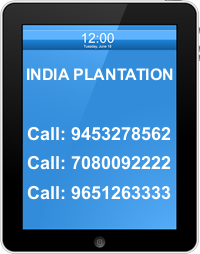Description
We are providing mahogany plant sapling, for more details call: +91- 9453 278562, 9651263333 or mail us on: info@indiaplantation.com
Description:-
A significant feature of the forest mahogany, particularly evident in those growing in open situations, is the beautiful dark foliage and large rounded crown. Impressive heights of up to 35 m. have been recorded, the tall main stem assuming a relatively straight and sometimes buttressed habit, up to 1.8 m. in diameter. The grey bark is smooth in texture, but often rough and segmented around the base of the main stem on older specimens.
The compound leaves can reach lengths of 70 cm and are imparipinnate with 3-5 pairs of leaflets and a terminal one, the petiole being 8-10 cm in length. The leaflets are entire, opposite to alternate, glossy and dark green in colour, and can attain a size of 21 cm in length and 8.5 cm in width. They exhibit 8-12 pairs of side veins, petiolules around 1 cm in length, and an under-surface that is hairless to slightly hairy and notably paler than above.
The fruits are round, velvety capsules, 3 cm in diameter that split usually into 3 valves. On splitting, the capsules reveal 6 very attractive seeds, these being black and covered largely by a bright red to scarlet aril, a striking and distinctive feature of the tree. Fruiting occurs mainly between January and May.
Look for a sunny spot. Mahogany trees do best when planted in areas that receive partial to full sun.
- Avoid heavily shaded areas.
- Also note that these trees are considered tropical varieties and thrive best in warm climates. Harsh winters can easily damage or destroy mahogany trees. Think twice about planting a mahogany tree if your winters reach below temperatures of 40 degrees Fahrenheit (4.4 degrees Celsius).
Check the soil. Mahogany trees can grow in a range of soil types, but they do thrive best in well-drained sandy loam soils.
- Avoid heavy clay soils and duplex soils.
- Additionally, mahogany trees do best in neutral soils. They can survive in strongly acidic soils, too, but avoid planting them in alkaline soils. If you need to use naturally alkaline soil, amend it with sphagnum peat, ammonium nitrate fertilizer, sulfur-coated urea, or agricultural sulfur.
- Most mahogany trees are resistant to salt spray, so soils frequently drenched by salt water mist should not present a problem.
- Since mahogany trees have deep root systems, you should make sure that the soil you plant it in runs deep, too.
Give the tree plenty of space. Plant the tree at least 15 feet (4.57 m) away from any house or large structure. It should also be 8 feet (2.43 m) or more away from side-walks, streets, and driveways.
- Mahogany trees tend to have large canopies and long roots, which is why appropriate spacing is so crucial.
- Similarly, it is best to plant multiple mahogany trees at least 15 feet (4.57 m) apart. You should be able to plant grasses, flowers, and small shrubs near the base of the tree without much problem, however.
Planting Mahogany Saplings
Dig a deep hole. Using a shovel, dig a hole that is at least 20 inches (50.8 cm) deep or as deep as the container presently holding the sapling.
- Between these two options, choose the depth that is deeper.
- The width of the hole should be twice as long as the diameter of the sapling root system.
Mix organic material into the hole. Add composted cow manure and topsoil to the hole, mixing it into the soil at the bottom and sides of the hole with a shovel or garden fork.
- Note that organic peat moss can be used instead of topsoil, if desired.
- If desired, you can skip the soil amendments altogether. Doing so can make it more difficult for the tree to establish itself, but if you wish to add fertilizer to the area after planting the tree, there shouldn’t be a problem.
Apply an herbicide. Spray the amended planting hole with a preventative “knock down” herbicide.
- Doing so is not strictly necessary, but it can help keep the growing area free from weeds for two years or so of growth, giving the tree enough time to establish itself in the process.
- Application amount can vary depending on the type of herbicide used, so follow the instructions on the label carefully.
Place the sapling in the planting hole. Free the sapling from its current container and place it directly into the centre of the prepared planting hole.
- If the sapling is in a traditional nursery container, carefully tip the container on its side and grab the tree at its base. Carefully wriggle the tree back and forth until it eases out of the container.
- Do not disturb the roots after removing the sapling.
- Stand the sapling upright in the centre of the planting hole. The roots should be completely beneath the soil line.
Settle the soil. Fill the remainder of the hole with soil and water well to help pack the soil in.
- For best results, fill half of the hole with soil, then thoroughly water this soil before proceeding.
- After the water appears to drain, fill the remainder of the hole with additional soil and water again.
Consider fertilizing the tree. To give the tree another boost and help the sapling establish itself, consider applying a balanced fertilizer containing equal parts nitrogen, phosphorus, and potassium.










